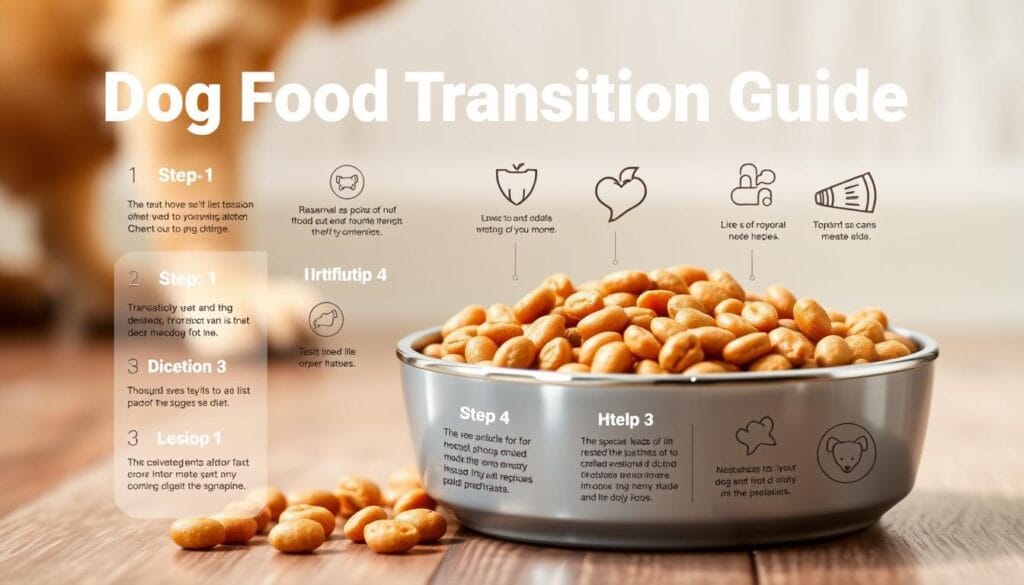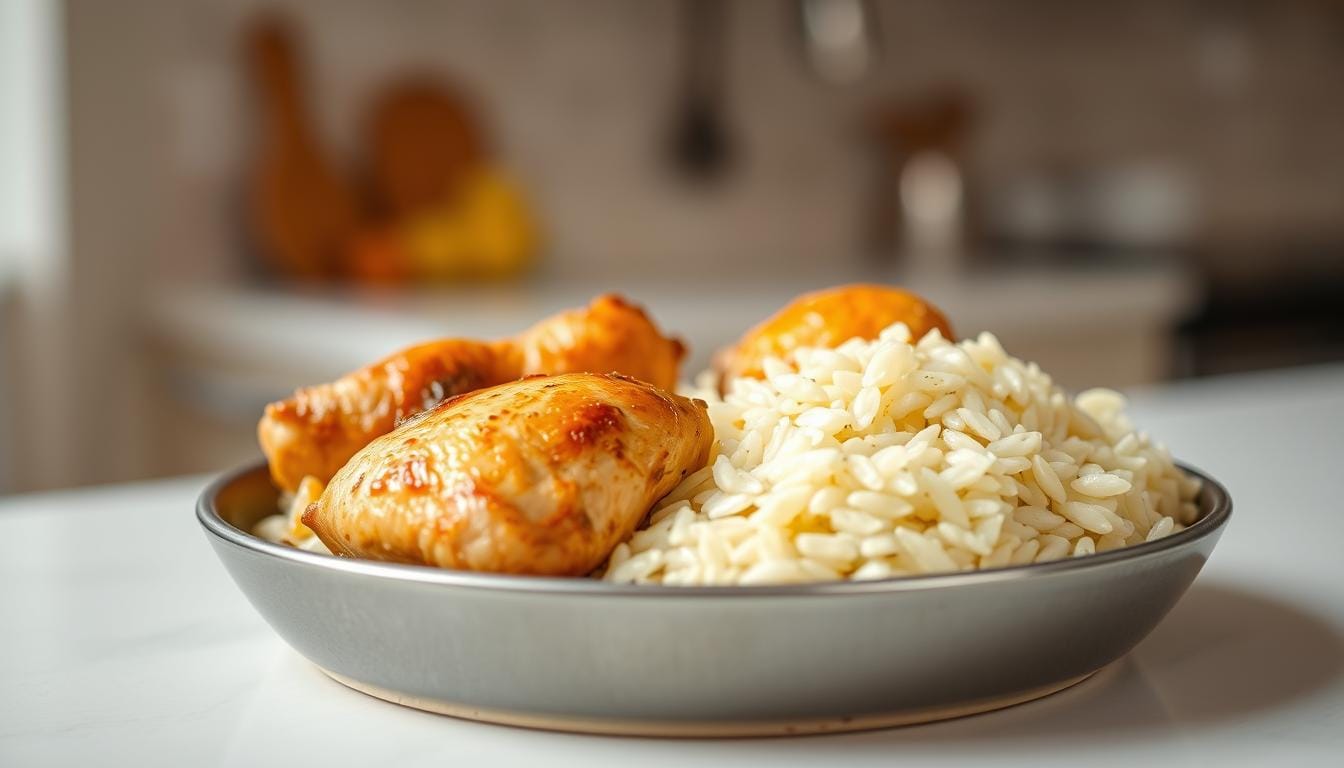Just for Dogs: Chicken & Rice Recipe
Are you tired of giving your dog mystery ingredients from commercial dog food? What if you could make a healthy, tasty chicken and rice recipe for them at home?
Homemade dog food recipes are changing how we feed our pets. They let owners control what their dogs eat. The JustFoodForDogs chicken and rice recipe is a healthy, tasty alternative to store-bought food. It’s full of good proteins, important nutrients, and love.
This easy recipe makes sure your dog gets the best nutrition. It doesn’t sacrifice taste or health. By cooking at home, you can give your dog a diet that fits their special needs.
Key Takeaways
- Create a nutritionally complete meal tailored to your dog’s needs
- Control ingredient quality and source
- Save money compared to premium commercial dog foods
- Improve your dog’s overall health and energy levels
- Learn simple cooking techniques for homemade dog food
Benefits of Homemade Dog Food with Chicken and Rice
Making your dog’s food at home gives you full control over what they eat. The chicken and rice recipe is a great way to ensure your dog gets the nutrients they need.
When you make your dog’s food, you can pick the best ingredients. This way, your dog gets the nutrients they need without harmful additives found in store-bought food.
Nutritional Value for Your Dog
The homemade chicken and rice recipe is packed with nutrients:
- Complete protein from ground chicken thighs
- Essential vitamins from fresh vegetables like spinach and carrots
- Balanced carbohydrates from enriched long-grain rice
- Omega-rich fish oil for coat and skin health
*Nutrition is the foundation of your dog’s health and longevity.*
Cost-Effectiveness Compared to Commercial Options
Homemade dog food can save you money compared to buying it. With the right ingredients, you can make high-quality meals at a fraction of the cost.
Quality Control of Ingredients
When you make your dog’s food, you know exactly what’s in it. This is important because many homemade diets are missing key nutrients, as studies have shown.
Important things to remember for homemade dog food include:
- Use 100% human-grade ingredients
- Follow precise nutritional guidelines
- Incorporate recommended nutrient blends
- Consult with veterinary nutritionists
While 84% of homemade dog food diets are lacking in nutrients, with careful planning and expert advice, you can avoid these problems.
Essential Ingredients for just for dogs chicken and rice recipe
Making a great just for dogs chicken and rice recipe needs the right ingredients. These ingredients should be high-quality and provide the best nutrition for your dog. The recipe includes protein-rich chicken, nutritious veggies, and important supplements to keep your dog healthy.
Here are the key ingredients for your homemade dog meal:
- Protein Sources:
- 2 lbs 4 oz ground chicken thighs (boneless, skinless)
- 1 lb 4 oz chicken thighs with skin (boneless)
- 6 oz chicken gizzards
- 5 oz chicken liver
- Carbohydrates:
- 24 oz long-grain enriched rice
- Vegetables:
- 8 oz spinach
- 8 oz carrots
- 8 oz green or red apples (cored and finely chopped)
- Nutritional Supplements:
- 2 tsp Omega Plus Fish Oil
- 5 1/4 tbsp JustFoodForDogs Chicken & Rice DIY Nutrient Blend
The JustFoodForDogs Nutrient Blend is key. It makes sure your recipe meets all the nutritional standards. This blend has 100% human-grade ingredients, regulated by the FDA. It offers a balanced diet for puppies and adult dogs.
Pro Tip: Always consult with your veterinarian before making significant changes to your dog’s diet, especially if your pet has specific dietary needs or food sensitivities.
With these ingredients, you’ll make a tasty and healthy natural dog food. It will support your dog’s health and happiness.
Kitchen Equipment and Preparation Tips
Making simple dog food recipes needs careful planning and the right tools. It’s more than just cooking. You need to know the right equipment, safety tips, and how much to serve.
Required Cooking Tools
You’ll need some key kitchen tools to make your dog’s food:
- Large cooking pot with lid
- Sharp kitchen knife
- Cutting board
- Measuring cups and spoons
- Digital kitchen scale
- Airtight storage containers
- Meat thermometer
Food Safety and Storage Guidelines
Food safety is very important when making dog food. Always wash your hands and surfaces before and after handling raw ingredients. Cook meats to 165°F to kill harmful bacteria.
“Fresh ingredients and proper handling are key to creating nutritious meals for your dog.” – Veterinary Nutrition Experts
Here’s how to store homemade dog food:
- Refrigerate meals for up to 4 days
- Freeze portions for up to 6 months
- Use airtight containers to keep food fresh
- Label containers with the date you made them
Portion Size Recommendations
Finding the right portion size depends on your dog’s weight, age, and how active they are. A general rule is to serve about 1 cup of food per 20 pounds of body weight daily. Talk to your vet to figure out the best amount for your dog.
Remember, homemade dog food should add to a balanced diet, not replace it without a vet’s advice.
Step-by-Step Cooking Instructions
Making a tasty homemade dog food recipe needs careful steps and focus. This just for dogs chicken and rice recipe is a healthy meal your dog will enjoy.
- Prepare the Ingredients
- Measure 1 cup (140 grams) of chicken breast
- Measure ½ cup (90 grams) of white rice
- Dice ¼ cup (40 grams) of carrots
- Have 2 cups of low-sodium chicken broth ready
- Cook the Chicken
- Heat a pan over medium heat
- Cook chicken thoroughly for 15-20 minutes
- Ensure internal temperature reaches 165°F
- Chop cooked chicken into small, dog-friendly pieces
- Prepare the Rice
- Rinse rice thoroughly
- Add rice to chicken broth
- Bring to a boil, then reduce heat
- Simmer for 15-20 minutes
- Add diced carrots during the last 5 minutes
When making homemade dog food, it’s important to control portions. The amount you serve depends on your dog’s size and how active they are. Smaller dogs might need a few tablespoons, while bigger dogs can have ½ to 1 cup.
| Nutritional Information | Per Serving (1 cup) |
|---|---|
| Calories | 250 |
| Protein | 25g |
| Carbohydrates | 30g |
| Fat | 2g |
Keep leftover homemade dog food in the fridge for up to 3 days or freeze for up to 3 months. Always check with your vet to make sure the recipe fits your dog’s nutritional needs.
Understanding the JustFoodForDogs Nutrient Blend
Making healthy dog food needs the right mix of nutrients. The JustFoodForDogs Nutrient Blend is key. It helps make top-notch dog food that meets your dog’s nutritional needs.
This special blend turns homemade meals into a full nutritional package. It makes sure your dog gets the best nutrition with every bite.
Key Components and Benefits
The blend has important vitamins and minerals. They follow AAFCO guidelines. The main benefits are:
- 100% human-grade nutraceuticals
- FDA-regulated ingredients
- Comprehensive nutritional support
- Balanced formula for all life stages
Proper Measurement and Integration
For the best results, measure carefully. Use 5 1/4 tablespoons of the blend per batch. This makes about 9 pounds of dog food.
Storage Requirements
Keep the blend effective by storing it in a cool, dry spot. Unopened blends can stay at room temperature. Opened ones should be sealed well and used within the suggested time.
Always talk to a vet to make sure the blend fits your dog’s diet.
Storage and Meal Planning

Preparing simple dog food recipes needs smart storage tips. This keeps your food fresh and full of nutrients. It makes mealtime easier and more convenient for you and your dog.
Refrigeration Guidelines
Here are important storage tips for your homemade dog food:
- Refrigerate meals in airtight containers
- Store for up to 4-5 days
- Keep the fridge at 40°F or below
Freezing Your Homemade Dog Food
Freezing is a great way to keep your dog food fresh longer. Meals can stay frozen for up to three months.
| Storage Method | Duration | Recommended Container |
|---|---|---|
| Refrigeration | 3-5 days | Airtight glass or plastic container |
| Freezing | Up to 3 months | Freezer-safe container or portion-sized bags |
Meal Portioning Tips
For easy meal planning, follow these tips:
- Divide meals into individual servings
- Label containers with the date
- Thaw frozen portions in the fridge overnight
Pro tip: Use portion-sized containers for quick and easy feeding, no matter your dog’s size.
Alternative Cooking Methods
Preparing simple dog food recipes doesn’t always need the stovetop. You can make nutritious meals for your pet with other kitchen tools. These tools make cooking easier and more convenient.
Various cooking methods can make healthy meals for your pet. They save time and keep the food’s nutritional value.
Crockpot Chicken and Rice Dog Food Preparation
Slow cookers are great for making homemade dog food. Here’s how to use your crockpot:
- Place chicken, rice, and veggies in the crockpot
- Cook on low for 4-6 hours
- Make sure chicken is 165°F inside
- Let it cool before serving
“Crockpots are a game-changer for busy pet owners wanting to prepare nutritious meals.” – Veterinary Nutrition Expert
Instant Pot Variations for Quick Dog Meals
If you want fast cooking, the Instant Pot is perfect. Here’s how to use it for simple dog food recipes:
- Add ingredients to the Instant Pot
- Set pressure cook for 10-12 minutes
- Use natural release
- Check chicken’s internal temperature
- Let meal cool completely before serving
Pro tip: Always check with your vet about portion sizes and ingredient ratios for homemade dog food.
Transitioning Your Dog to Homemade Food
Switching your dog to homemade food needs careful planning and patience. The move from commercial to homemade meals should be slow. This helps avoid digestive issues and meets your pet’s nutritional needs.

- Start by mixing 25% new homemade food with 75% current food
- Gradually increase homemade food proportion over 5-7 days
- Monitor your dog’s digestive response and overall health
- Watch for signs of improved energy and reduced skin irritations
Keep an eye on your dog’s weight, appetite, and stool. Some dogs might need time to adjust to new food.
| Transition Stage | Homemade Food Percentage | Days |
|---|---|---|
| Initial Mix | 25% | 1-2 |
| Moderate Mix | 50% | 3-4 |
| Primary Mix | 75% | 5-7 |
Always consult your veterinarian before making significant dietary changes to ensure the homemade recipe meets your dog’s specific nutritional requirements.
Nutritional Considerations and Customization
Making healthy dog food means thinking about what your pet needs. The chicken and rice recipe is a good start. But, you must tailor it to your dog’s specific needs for the best nutrition.
When making vet-approved dog recipes, remember these key points:
- Age-specific dietary requirements
- Activity level and metabolism
- Potential allergies or sensitivities
- Existing health conditions
Adult dogs need a balanced diet to stay healthy and full of energy. Puppies need more protein to grow. Senior dogs do better with easy-to-digest meals and adjusted nutrients.
Your vet can help you tweak the chicken and rice recipe for your dog. You can:
- Add organ meats for extra nutrition
- Use omega-3 rich ingredients like sardines
- Change protein levels based on how active your dog is
- Add supplements for specific health needs
If your dog has health issues, making special changes can help a lot. There are kidney-friendly, low-fat, and allergy-specific recipes available with vet advice.
Always talk to a vet to make sure your homemade dog food is right for your pet.
Homemade Dog Treats and Variations
Making homemade dog treats is a fun way to give your pet tasty and healthy snacks. Simple recipes let you pick the best ingredients for your dog’s diet.
It’s important to know which foods are safe and good for dogs. Since dogs are omnivores, they can eat many foods. But, some foods are not safe.
- Avoid toxic ingredients like chocolate, grapes, and xylitol
- Use dog-friendly fruits in moderation
- Choose lean proteins and whole grains
Here are some tasty homemade dog treat ideas:
- Chicken and Rice Bites
- ⅓ cup ground chicken
- ¾ cup cooked rice
- 1 beaten egg
- Sweet Potato Fries
- 1 sweet potato
- Bake at 350°F for 25-30 minutes
- Peanut Butter Treats
- 1 cup all-natural peanut butter
- 2 eggs
- 2½ cups whole wheat flour
Remember: Always introduce new treats gradually and watch for any allergic reactions.
When making homemade dog treats, keep the sizes small. For a regular-sized dog, here are some fruit treat sizes:
| Fruit | Recommended Portion |
|---|---|
| Banana | Less than half |
| Apple | Two slices |
| Watermelon | A few chunks |
Always talk to your vet before changing your dog’s diet. This is especially true if your dog has health issues or food allergies.
Conclusion
Making a just for dogs chicken and rice recipe is more than cooking. It’s an investment in your dog’s health. By making homemade dog food, you control what goes into it. This ensures your dog gets the best nutrition for their needs.
Healthy dog food doesn’t have to be hard to make. The chicken and rice mix is easy and good for your dog’s stomach. Studies show homemade meals are 40% more digestible than kibble. This means better nutrition for your dog.
Preparing healthy meals shows how much you care for your pet. It’s not just about health; it’s about showing love through quality ingredients. This supports your dog’s overall health and happiness.
Always talk to your vet before changing your dog’s diet. Watch how they react and adjust the food as needed. Your effort to make healthy meals will make your dog happy and healthy for a long time.

